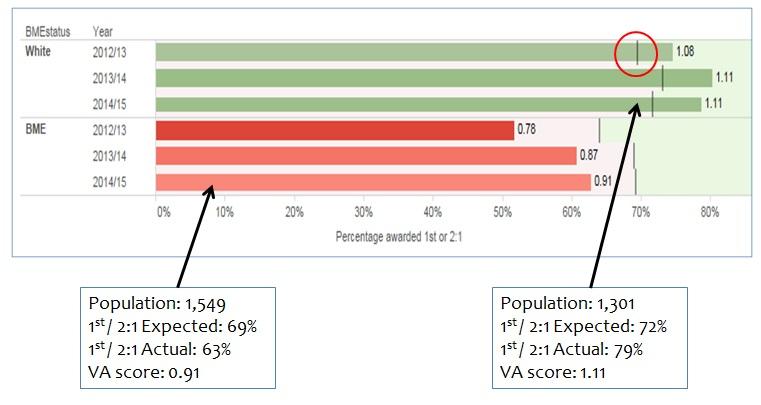While the Black and Minority Ethnic (BAME) attainment gap may be well known within the higher education (HE) sector, the use of metrics is crucial in helping define the size of the gap and key in assessing the success of interventions implemented to address the gap.
For Kingston University, a key element in addressing the BAME attainment gap is the use of the value-added (VA) metric. An important part of this project was looking at the transferability of the VA score into other institutions (the VA score was developed and rolled out at Kingston University) and to see if similar success could be replicated.
What Are Value-added Scores and Why Use Them?
Kingston University adapted the method of calculating VA scores, originally created for The Guardian newspaper league tables by Kingston University’s Head of Planning, so that subject of study is considered in addition to entry qualifications when setting expectations for each student. VA scores above 1.0 are good – they indicate that the students concerned have exceeded expectations. Scores under 1.0 show that the distribution of awards to the group concerned contained fewer 1st and 2:1s than would be expected given the profile of the students and how similar students throughout the sector fared.
The major advantage of the VA-score approach is that it enables Kingston University to create a story for each student by taking account of prior entry qualifications and subject of study when assessing their degree attainment. By using data for all graduates across higher education in the last five years, they can arrive at the probability that a given student will achieve a 1st or 2:1 degree. If the cohort achieves this percentage then the VA score is 1.0, for attainment above or below the expectation, the VA score will be proportionately greater or less than 1.0.

The value-added score: how to use the dashboards
Click here to see a breakdown of the tableau dashboard. This contains annotated screenshots of the type of information that it is possible to generate and demonstrates the potential value having this information could be for your institution.
Click here to access an interactive video guide to using the value added data in Tableau.
Interested in adopting a value added metric at your university?
Dissemination of the VA data and Kingston University's overall approach has been carried out through a series of meetings with academic teams, creating a safe environment in which to discuss the attainment gap and facilitating conversations around influencing factors and the support available.
Value-added data at this level has proved a very powerful means of engaging staff in discussion around the attainment gap. Meetings are used to explain the VA data, discuss the research evidence around the attainment gap, describe the support activities available and hear of initiatives and notable practice taking place in departments. The initial focus has been on those courses with the largest attainment gap. We believe that these meetings have been an essential part of the drive to address the gap.
How Kingston University implemented the VA score - This document contains in more detail how Kingston has approached rolling out the VA and potential next steps that could be taken within your institution.
The below Prezi details the steps to be taken to calculate the value added score.
Collaborators speak out
Hertfordshire and Wolverhampton Universities speak out about their experience of using the value- added score system and the potential benefits and challenges.
Value Added at University of Hertfordshire and University of Wolverhampton.
Potential challenges of introducing the VA score and ways to address these challenges.